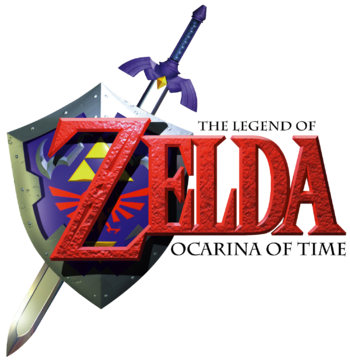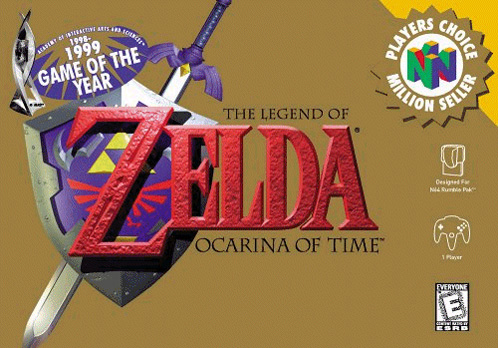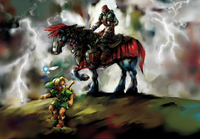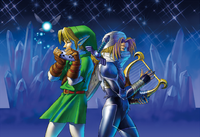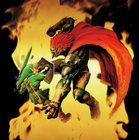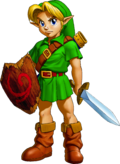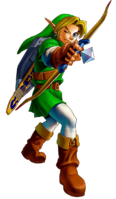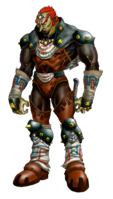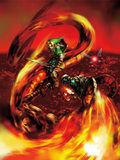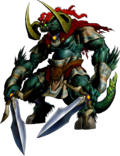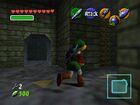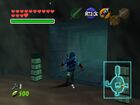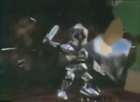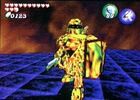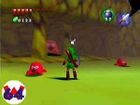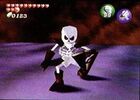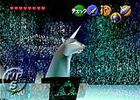The Legend of Zelda: Ocarina of Time: Difference between revisions
mNo edit summary |
m (Hyperlink change: Link's Awakening → Link's Awakening (Game Boy)) |
||
| (89 intermediate revisions by 32 users not shown) | |||
| Line 1: | Line 1: | ||
< | <section begin=infobox />{{Infobox|game | ||
| name = ''Ocarina of Time'' | | name = ''Ocarina of Time'' | ||
| logo = [[File: | | logo = [[File:OoT_logo.png|350px|center]] | ||
| boxart = [[File:OoTBoxArt.jpg]] | | boxart = [[File:OoTBoxArt.jpg]] | ||
| release [[Nintendo 64]] = | | release [[Nintendo 64]] = | ||
| Line 7: | Line 7: | ||
{{Region|us|y=1998|m=11|d=23}} | {{Region|us|y=1998|m=11|d=23}} | ||
{{Region|eu|y=1998|m=12|d=11}} | {{Region|eu|y=1998|m=12|d=11}} | ||
| release [[Nintendo GameCube|Nintendo<br>GameCube]] = | | release [[Nintendo GameCube|Nintendo<br/>GameCube]] = | ||
{{Region|jp|y=2003|m=11|d=7}} | {{Region|jp|y=2003|m=11|d=7}} | ||
{{Region|eu|y=2003|m=11|d=14}} | {{Region|eu|y=2003|m=11|d=14}} | ||
| Line 13: | Line 13: | ||
{{Region|au|y=2004|m=3|d=19}} | {{Region|au|y=2004|m=3|d=19}} | ||
{{Region|kr|y=2002|}} | {{Region|kr|y=2002|}} | ||
| release [[Nintendo Wii#Virtual Console|Wii Virtual<br>Console]] = | | release [[Nintendo Wii#Virtual Console|Wii Virtual<br/>Console]] = | ||
{{Region|eu|y=2007|m=2|d=23}} | {{Region|eu|y=2007|m=2|d=23}}rst | ||
{{Region|jp|y=2007|m=2|d=26}} | {{Region|jp|y=2007|m=2|d=26}} | ||
{{Region|us|y=2007|m=2|d=26}} | {{Region|us|y=2007|m=2|d=26}} | ||
| release [[Nintendo 3DS]] = | | release [[Nintendo Wii U#Virtual Console|Wii U Virtual<br/>Console]] = | ||
{{Region|eu|y=2015|m=7|d=2}} | |||
{{Region|us|y=2015|m=7|d=2}} | |||
{{Region|jp|y=2015|m=12|d=22}} | |||
| release [[IQue Player]] = | |||
{{Region|cn|y=2003|m=11|d=17}} | |||
| release [[Nintendo 3DS]]<br>(''[[The Legend of Zelda: Ocarina of Time 3D|Ocarina of Time 3D]]'')= | |||
{{Region|jp|y=2011|m=6|d=16}} | {{Region|jp|y=2011|m=6|d=16}} | ||
{{Region|eu|y=2011|m=6|d=17}} | {{Region|eu|y=2011|m=6|d=17}} | ||
| Line 23: | Line 29: | ||
{{Region|au|y=2011|m=6|d=30}} | {{Region|au|y=2011|m=6|d=30}} | ||
{{Region|kr|y=2012|m=09|d=27}} | {{Region|kr|y=2012|m=09|d=27}} | ||
| release [[Nintendo Switch]]:<br/>NS Online + Expansion Pack = | |||
{{Region|ww|y=2021|m=10|d=25}} | |||
| developer = [[Nintendo EAD]] | | developer = [[Nintendo EAD]] | ||
| publisher = [[Nintendo|Nintendo Co., Ltd.]] | | publisher = [[Nintendo|Nintendo Co., Ltd.]] | ||
| producer = [[Shigeru Miyamoto]] | | producer = [[Shigeru Miyamoto]] | ||
| director = Shigeru Miyamoto<br>[[Yoichi Yamada]]<br>[[Eiji Aonuma]]<br>[[Yoshiaki Koizumi]] | | director = Shigeru Miyamoto<br/>[[Yoichi Yamada]]<br/>[[Eiji Aonuma]]<br/>[[Yoshiaki Koizumi]] | ||
| walkthrough = | | walkthrough = | ||
[ | [https://www.zeldadungeon.net/ocarina-of-time-walkthrough/ Text Walkthrough] | ||
[ | [https://www.youtube.com/playlist?list=PL8C7A9D9AD3CC39F8 Video Walkthrough] | ||
| guides = | | guides = '''List:''' | ||
[ | *[[Ocarina of Time Soft Soil Locations|Bean Bed Locations]] | ||
[ | *[[Ocarina of Time Big Poe Guide|Big Poes]] | ||
[ | *[[Ocarina of Time Bosses|Bosses]] | ||
[ | *[[Ocarina of Time Bottles|Bottles]] | ||
[ | *[[Ocarina of Time Characters|Characters]] | ||
[ | *[[Ocarina of Time Races|Races]] | ||
[ | *[[Ocarina of Time Enemies|Enemies]] | ||
[ | *[[Ocarina of Time Epona Quest|Epona Quest]] | ||
[ | *[[Ocarina of Time Fairy Fountains|Fairy Fountains]] | ||
[ | *[[Ocarina of Time Fishing Guide|Fishing Pond]] | ||
[ | *[[Forest Stage]] | ||
*[https://www.zeldadungeon.net/ocarina-of-time-walkthrough/ocarina-of-time-gerudo-training-ground-and-ice-arrow-guide/ Gerudo Training Grounds] | |||
*[[Ocarina of Time Glitches|Glitches]] | |||
[ | *[[Ocarina of Time Gold Skulltulas|Gold Skulltulas]] | ||
[ | *[[Ocarina of Time Gossip Stones|Gossip Stones]] | ||
[ | *[[Ocarina of Time Heart Pieces|Heart Pieces]] | ||
[ | *[[Ocarina of Time Items|Items]] | ||
[ | *[[Ocarina of Time Masks|Masks]] | ||
[ | *[[Ocarina of Time Scarecrow's Song|Scarecrow's Song]] | ||
[ | *[[Ocarina of Time Shops|Shops]] | ||
[ | *[[Ocarina of Time Songs|Ocarina Songs]] | ||
[ | *[[Ocarina of Time Biggoron's Sword Trading Sequence|Trading Sequence]] | ||
[ | *[[Ocarina of Time Upgrades|Upgrades]] | ||
| gallery = | | gallery = | ||
[ | [[zdgalleryt:318|Beta Version]] | ||
[ | [[Ending of Ocarina of Time|Ending Screenshots]] | ||
[ | [[zdgallery:12|Image Gallery]] | ||
| music = | | music = | ||
[ | [[Ocarina of Time Midis|Midis]] | ||
[ | [[The Legend of Zelda: Ocarina of Time Original Soundtrack|Soundtrack]] | ||
[ | [[The Legend of Zelda: Ocarina of Time Hyrule Symphony|Hyrule Symphony]] | ||
}} | [[The Legend of Zelda: Ocarina of Time Re-Arranged Album|Re-Arranged]] | ||
}}<section end=infobox /> | |||
{{ZD|[https://www.zeldadungeon.net/ocarina-of-time-walkthrough/ ''Ocarina of Time'' Walkthrough]}} | |||
'''''The Legend of Zelda: Ocarina of Time''''' is the fifth installment in [[The Legend of Zelda (Series)|''The Legend of Zelda'' series]]. It is preceded by ''[[The Legend of Zelda: Link's Awakening (Game Boy)|Link's Awakening]]'' and followed by ''[[The Legend of Zelda: Majora's Mask|Majora's Mask]]''. ''Ocarina of Time'' was praised by critics and players alike for its intuitive storyline and time travel mechanics | |||
and its [[3D Zelda Games|3D graphical style]], which was new technology at the time. Like previous ''Zelda'' titles, ''Ocarina of Time'' was directed and produced by [[Shigeru Miyamoto]], who also worked on [[Nintendo]] titles including the Super Mario series and Donkey Kong. ''Ocarina of Time'' was very well received by critics and it is one of the few video game titles to have received a perfect score from gaming magazine ''Famitsu''. ''Ocarina of Time'' has received numerous awards and perfect scores in multiple gaming magazines. The game was originally released on the Nintendo 64 in [[Ocarina of Time Versions|numerous versions]], and emulated versions of the title have been released on [[Nintendo GameCube]] (GCN), [[Nintendo Wii|Wii]], [[Nintendo Wii U|Wii U]], and [[Nintendo Switch]]; it was available in China on the [[iQue Player]] (iQue); while [[The Legend of Zelda: Ocarina of Time 3D|a remake]] is available for the [[Nintendo 3DS]]. | |||
The base game mechanic behind ''Ocarina of Time'' is its titular "time travel" concept in which the hero travels backward and forward seven years in time by removing the [[Master Sword]] from its pedestal in the [[Temple of Time]] or vice versa. This blade is in turn used to defeat the game's boss monsters and seal the King of Evil, [[Ganon]]dorf, in the [[Sacred Realm]]. Time travel is also used heavily in the various side stories and side quests. The other massive innovation is the use of the [[Ocarina of Time]]. The use of this instrument allows the hero to teleport to various locations, influence certain elements of the scenery, influence the time of day and the weather, speak with the hero's friend [[Saria]], and summon your horse. This aspect introduced a heavy use of instruments in the series and has popularized the ocarina instrument since. | |||
The base game mechanic behind ''Ocarina of Time'' is its titular "time travel" concept in which the hero travels backward and forward seven years in time by removing the [[Master Sword]] from its pedestal in the [[Temple of Time]] or vice versa. This blade is in turn used to defeat the game's boss monsters and seal the King of Evil, [[Ganon | |||
==Story== | ==Story== | ||
{{Main|Ocarina of Time Story}} | [[File:Ocarina_of_Time.png|30px|left]]{{Main|Ocarina of Time Story}} | ||
{{Spoiler|section}} | {{Spoiler|section}} | ||
The story of ''Ocarina of Time'' revolves around the Gerudo King and evil wizard, Ganondorf | The story of ''Ocarina of Time'' revolves around the Gerudo King and evil wizard, Ganondorf's rise to power and the hero, [[Link (Ocarina of Time)|Link]]'s quest to defeat him and return peace to the land of [[Hyrule]] once again. The game opens with the hero's mentor and protector, the [[Great Deku Tree]], sending a fairy, [[Navi]], to inform the hero about his new responsibilities. Navi escorts the hero to the Great Deku Tree who explains that Ganondorf has come to the land of Hyrule and is vying for power. The hero leaves his home in [[Kokiri Forest]] and travels to [[Hyrule Castle]] to meet [[Zelda (Ocarina of Time)|Princess Zelda]]. She explains to Link about a dream that she had in which all of Hyrule was covered in dark clouds. She asks Link to collect the [[Spiritual Stones]] of [[Goron's Ruby|Fire]] and [[Zora's Sapphire|Water]]. The young hero goes to [[Castle Town|Hyrule Castle Town]] and watches the Princess being pursued by Ganondorf. At this point, [[Zelda (Ocarina of Time)|Princess Zelda]] gives Link the Ocarina of Time. Link continues onward, undaunted, to the Temple of Time where he receives the Master Sword. | ||
After removing the Master Sword from the [[Pedestal of Time]], the hero falls into a deep sleep for seven years. When | After removing the Master Sword from the [[Pedestal of Time]], the hero falls into a deep sleep for seven years, guarded by the sage Rauru. When Link awakens, he discovers that much has changed during the seven years he spent sleeping. Rauru explains to Link what he must do, giving him hints on how and where to find the other sage medallions. With the help of [[Sheik]], the hero travels to the temples and awakens the [[Sage|six Sages]]. The hero travels to the Temple of Time once more where he discovers that Sheik is actually Zelda. Ganondorf comes and captures the princess. The hero travels to Ganondorf's castle. Ganondorf confronts him for a final showdown, in which he utilizes the power hidden in the Master Sword and the [[Light Arrow]]s to weaken and then defeat Ganondorf. The hero and Princess Zelda manage to escape, but before they can leave the ruins, they are confronted by Ganondorf in his true form (Ganon). The hero defeats him once again, and with the aid of Princess Zelda and the six other Sages, traps the evil king in the Sacred Realm. The Princess thanks the hero and returns him to his childhood. | ||
==Gameplay== | |||
''Ocarina of Time'' is the first game in the [[The Legend of Zelda (Series)|''Legend of Zelda'' series]] to introduce a fully 3D environment. ''Ocarina of Time'' also pioneered the [[Z-target]]ing combat mechanic, which allows the player to lock onto an enemy or other objects. It is also useful for non-combat situations, such as locating important elements in a dungeon room, or talking to a character who is out of reach. This mechanic is now a staple of the 3D games in ''The Legend of Zelda'' series. | |||
At a certain point in the game, the player may choose to complete a side quest where the player obtains Link's horse Epona. This allows the player to cross Hyrule at a much faster pace than before. | |||
==Races== | ===Races=== | ||
''Ocarina of Time'' was the first game in the franchise to feature several vastly different races. The different races are based on the different terrains throughout the main regions of the game. | ''Ocarina of Time'' was the first game in the franchise to feature several vastly different races. The different races are based on the different terrains throughout the main regions of the game. | ||
{{ | {{Galbox|width=auto;display:grid;max-width:fit-content;min-width:777px;margin-left:auto;margin-right:auto;clear:none;|Ocarina of Time Races|gallery_perrow=7}} | ||
== | ===Characters=== | ||
{{ | {{Galbox|width=auto;display:grid;max-width:fit-content;min-width:777px;margin-left:auto;margin-right:auto;clear:none;|Ocarina of Time Characters|gallery_perrow=7}} | ||
- | ===Enemies=== | ||
{{Galbox|width=auto;display:grid;max-width:fit-content;min-width:777px;margin-left:auto;margin-right:auto;clear:none;|Ocarina of Time Enemies|gallery_perrow=7}} | |||
===Bosses and Mini-Bosses=== | |||
{{Galbox|width=auto;display:grid;max-width:fit-content;min-width:777px;margin-left:auto;margin-right:auto;clear:none;|Ocarina of Time Bosses|gallery_perrow=7}} | |||
}} | |||
== | ===Dungeons=== | ||
{{ | {{Galbox|width=auto;display:grid;max-width:fit-content;min-width:777px;margin-left:auto;margin-right:auto;clear:none;|Ocarina of Time Dungeons|gallery_perrow=7}} | ||
===Items=== | |||
{{Galbox|width=auto;display:grid;max-width:fit-content;min-width:777px;margin-left:auto;margin-right:auto;clear:none;|Ocarina of Time Items|gallery_perrow=7}} | |||
== | ===Locations=== | ||
In ''Ocarina of Time'', Link starts off in his home at Kokiri Forest. The forest is where the first dungeon of the game takes place inside the Great Deku Tree. In Kokiri Forest, there are many townsfolk, including the leader [[Mido]] and Link's best friend, Saria. There is a place called the [[Lost Woods]] within the forest. Saria has a hideout there next to the [[Forest Temple (Ocarina of Time)|Forest Temple]], which is unreachable as a kid. Out of Kokiri Forest, there is a place called [[Hyrule Field]], the largest area in the game. Every location is connected to it, with Hyrule Field being at the center of these locations acting as almost a hub world. As a kid, Link must run very far across the field. As an adult, Link can have an optional event to get a horse, [[Epona]], which makes travel much more efficient in Hyrule Field. The next area Link can visit is the Market, which is where the majority of townsfolk, stores, and games are located. The Bazaar, a store with many convenient wares such as the Hylian shield is first encountered at the Market. There is also a Potion Shop, which sells potions to refill Link's life and Magic Meter. Next is the [[Happy Mask Shop]], which gives Link the option to embark on a series of side quests selling masks. If Link completes these missions, he can obtain the [[Mask of Truth]]. | |||
{{Galbox|width=auto;display:grid;max-width:fit-content;min-width:777px;margin-left:auto;margin-right:auto;clear:none;|Ocarina of Time Locations|gallery_perrow=7}} | |||
{{ | |||
== | ===Heart Pieces=== | ||
{{ | [[File:Piece of Heart (Ocarina of Time).png|25px|left|bottom-text]]{{Main|text-alignment=center|Ocarina of Time Heart Pieces}} | ||
Ocarina of Time features 36 heart pieces scattered across Hyrule. It takes four Pieces of Heart to form a full Heart Container, meaning there are 9 potential Heart Containers for you to find! This combined with the 3 starting heart containers, as well as the 8 heart containers obtained from completing the dungeons allows Link's total health to increase to 20 hearts. | |||
==Reception== | |||
Reviews for ''Ocarina of Time'' were extremely good. The most notable being IGN's review for the game which was a perfect 10/10.{{Ref|[https://www.ign.com/articles/1998/11/26/the-legend-of-zelda-ocarina-of-time-review IGN]}} This perfect score was the very first IGN had ever given out. This game is commonly referred to as the best ''Zelda'' game and one of the best games ever. | |||
== | |||
{{ | |||
==Beta== | |||
The beta for ''Ocarina of Time'' holds many mysteries. Although nobody knows for sure what the original plot of the game was in the beta, there are some facts known. In early stages of development, the Lost Woods were a fully 3D environment. Remnants of a location dubbed the [[Unicorn Fountain]] by fans have also been found in ''Ocarina of Time'''s code, though it cannot be found in the regular game. One early video showed Link receiving the full [[Triforce]], causing many rumors that it could be obtained in the game. Several people suggested that the Unicorn Fountain was related to the Triforce. However, there is no proof that the Triforce ever was or is in the game's code. Another cool fact about the beta is that the medallions received from the Sages were items that granted special powers. It is believed that they were initially used to warp instead of the Ocarina of Time. An unnamed group of ROM Hackers managed to find a frozen NPC in the game's data of a character who they believed was supposed to replace Navi. The hackers are currently working at trying to make her fully functional and hope to eventually release a patch that makes her compatible with the current game Additionally, the code for two medallions that are not seen in the game appeared that translate into Wind Medallion and Earth Medallion. | |||
An expansion to ''Ocarina of Time'', known as Ura Zelda, was planned to make use of the Nintendo 64 Disk Drive and add new dungeons.{{Ref|[[Interview:IGN August 27th 1999|IGN August 27th, 1999]]|Ura Zelda is based on The Ocarina of Time for 64DD.|Shigeru Miyamoto}} However, due to poor reception and little support of the Disk Drive, the project was scrapped. Afterward, [[Eiji Aonuma]], the director of the ''Zelda'' franchise, asked Miyamoto for permission to make an entirely new ''Zelda'' game within a year so that he did not have to work on it any longer.{{Ref|[[Interview:Iwata Asks: Spirit Tracks|Iwata Asks: Spirit Tracks]]|Ultimately, other staff members handled The Legend of Zelda: Ocarina of Time: Master Quest. Still, as someone who has been in charge of the dungeons, I just couldn't get that excited over making a flip-side for them. I couldn't see it turning into a new The Legend of Zelda, either. But we'd been told to make The Legend of Zelda. It isn't as though we could just say, "I don't want to", and end it there. At that point, Miyamoto-san gave us a tradeoff: he said, if we could make a new The Legend of Zelda game in one year, then it wouldn't have to be a "flip-side". | |||
|Eiji Aonuma}} Miyamoto agreed, and this game became ''[[The Legend of Zelda: Majora's Mask|Majora's Mask]]'', code-named Zelda Gaiden (Zelda Side-Story) at the time. The rest of Ura Zelda most likely became ''[[The Legend of Zelda: Ocarina of Time Master Quest|Master Quest]]''. | |||
and | |||
==Other Media== | ==Other Media== | ||
*[[The Legend of Zelda: Ocarina of Time (Manga)]] is the official manga for ''Ocarina of Time''. It is written and illustrated by [[Akira Himekawa]], and it is divided into two volumes. | *[[The Legend of Zelda: Ocarina of Time (Manga)]] is the official manga for ''Ocarina of Time''. It is written and illustrated by [[Akira Himekawa]], and it is divided into two volumes. | ||
*[[The Legend of Zelda: Ocarina of Time (Comic)]] was published in a special edition of the European Club Nintendo magazine in 1998. This | *[[The Legend of Zelda: Ocarina of Time (Comic)]] was published in a special edition of the European Club Nintendo magazine in 1998. This comic provides the background story to ''Ocarina of Time''. | ||
*[[The Legend of Zelda: The Abridged Series]] is a fan-made parody series released on YouTube by [ | *[[The Legend of Zelda: The Abridged Series]] is a fan-made parody series released on YouTube by [https://www.youtube.com/user/adamwestslapdog adamwestslapdog]. | ||
*[[Ocarina of Time Instruction Manual|Instructional Manual]]s: | |||
**[[Ocarina of Time North American Instruction Manual|North America N64]] | |||
**[[Ocarina of Time Japanese Instruction Manual|Japan]] | |||
**[[Ocarina of Time French and Dutch Instruction Manual|French/Dutch]] | |||
**[[Ocarina of Time Master Quest Instruction Manual|North America GCN & Master Quest]] | |||
==Merchandise== | ==Merchandise== | ||
*[[How to Draw The Legend of Zelda]] is a guide book to drawing some of the characters, enemies, and bosses from ''Ocarina of Time'' and ''Majora's Mask''. | *[[How to Draw The Legend of Zelda]] is a guide book to drawing some of the characters, enemies, and bosses from ''Ocarina of Time'' and ''Majora's Mask''. | ||
''Ocarina of Time'' has more merchandise than that of any other Zelda title. UFO catcher plushes, figures by BD&A, statues by First 4 Figures, and even some clothing to name a few. | ''Ocarina of Time'' has more merchandise than that of any other ''Zelda'' title. UFO catcher plushes, figures by BD&A, statues by First 4 Figures, and even some clothing to name a few. | ||
Multiple versions of the soundtrack were released, mostly in Japan: | |||
*[[The Legend of Zelda: Ocarina of Time Original Soundtrack]] | |||
*[[The Legend of Zelda: Ocarina of Time Hyrule Symphony]] | |||
*[[The Legend of Zelda: Ocarina of Time Nintendo Power Soundtrack]] | |||
*[[The Legend of Zelda: Ocarina of Time 3D Official Soundtrack]] | |||
*[[The Legend of Zelda: Ocarina of Time Re-Arranged Album]] | |||
*[[The Legend of Zelda: Ocarina of Time (Nintendo of Europe Soundtrack)]] | |||
*[[The Legend of Zelda: Ocarina of Time Vol. II The Lost Tracks]] | |||
==Trivia== | |||
*The title screen music is a reference to the song played when the [[Recorder]] is used in ''[[The Legend of Zelda]]''. | |||
==Gallery== | |||
===Scene Artwork=== | |||
{{main|Gallery:Ocarina of Time}} | |||
<gallery widths="200" heights="140"> | |||
File:Link-Encountering-Ganondorf.png|Child Link's first encounter with Ganondorf | |||
File:Link-Sheik-Instruments.png|Adult Link and [[Sheik]] playing their instruments | |||
File:Link-Fighting-Ganondorf-Fire.png|Link fighting Ganondorf | |||
</gallery> | |||
===Characters=== | |||
{{main|Gallery:Ocarina of Time Characters}} | |||
<gallery heights=200> | |||
File:Young-Link-Art.png|Child Link | |||
File:Young-Zelda-Art.png|Child Zelda | |||
File:OoT-Link-FairyBow.png|Adult Link w/[[Fairy Bow]] | |||
File:Ganondorf-Art.png|Ganondorf | |||
</gallery> | |||
===Bosses=== | |||
{{main|Gallery:Ocarina of Time Bosses}} | |||
<gallery heights=160> | |||
Barinade 1.png|N64 model of Barinade | |||
File:Link-Fighting-Volvagia.png|Link Fighting [[Volvagia]] | |||
Ganon-Ocarina.png|Official artwork of Ganon | |||
</gallery> | |||
==Screenshots== | ===Screenshots=== | ||
<gallery> | <gallery widths="140" heights="105"> | ||
File:Oot-1.jpg | File:Oot-1.jpg | ||
File:Oot-2.jpg | File:Oot-2.jpg | ||
| Line 231: | Line 191: | ||
</gallery> | </gallery> | ||
==Videos== | ====Beta screenshots==== | ||
{{Youtube| | <gallery widths=140 heights=105> | ||
{{Youtube|evI5pF5h8Ck|270|European | File:Darknut-Beta-OOT.png|[[Darknut]] (earlier) | ||
{{Youtube|jdZFCKSWpTA|270|Japanese | File:DarknutV2-Beta-OOT.jpg|[[Darknut]] (later) | ||
File:Octorok-Beta-OOT.jpg|[[Octorok]] | |||
File:Stalfos-Beta-OOT.jpg|[[Stalfos]] | |||
File:Unicorn Fountain.jpg|"[[Unicorn Fountain]]" | |||
</gallery> | |||
===Videos=== | |||
{{Youtube|iu_nQwZn02E|270|American Commercial}} | |||
{{Youtube|evI5pF5h8Ck|270|European Commercial}} | |||
{{Youtube|jdZFCKSWpTA|270|Japanese Commercial}} | |||
{{Youtube|oXtl4wcUlDw|270|French Beta Commercial/Demo}} | {{Youtube|oXtl4wcUlDw|270|French Beta Commercial/Demo}} | ||
{{Youtube|kSXpRpsDAhc|270|Brazilian Commercial}} | |||
{{Youtube|CtMllWsML5M|270|Game Intro}} | {{Youtube|CtMllWsML5M|270|Game Intro}} | ||
{{Youtube|PL8C7A9D9AD3CC39F8|270|Zelda Dungeon Video Walkthrough}} | |||
{{Clear}} | {{Clear}} | ||
Latest revision as of 01:01, September 28, 2024
| Release | ||
|---|---|---|
Platform | Date | |
| ||
Nintendo Switch: | 🌎 October 25, 2021 | |
| Credits | ||
Developer | ||
Publisher | ||
Producer | ||
Director | Shigeru Miyamoto | |
| Guides | ||
Walkthrough | ||
| Media | ||
Gallery | ||
Music | ||

|
In-depth guide:
Ocarina of Time Walkthrough |
The Legend of Zelda: Ocarina of Time is the fifth installment in The Legend of Zelda series. It is preceded by Link's Awakening and followed by Majora's Mask. Ocarina of Time was praised by critics and players alike for its intuitive storyline and time travel mechanics and its 3D graphical style, which was new technology at the time. Like previous Zelda titles, Ocarina of Time was directed and produced by Shigeru Miyamoto, who also worked on Nintendo titles including the Super Mario series and Donkey Kong. Ocarina of Time was very well received by critics and it is one of the few video game titles to have received a perfect score from gaming magazine Famitsu. Ocarina of Time has received numerous awards and perfect scores in multiple gaming magazines. The game was originally released on the Nintendo 64 in numerous versions, and emulated versions of the title have been released on Nintendo GameCube (GCN), Wii, Wii U, and Nintendo Switch; it was available in China on the iQue Player (iQue); while a remake is available for the Nintendo 3DS.
The base game mechanic behind Ocarina of Time is its titular "time travel" concept in which the hero travels backward and forward seven years in time by removing the Master Sword from its pedestal in the Temple of Time or vice versa. This blade is in turn used to defeat the game's boss monsters and seal the King of Evil, Ganondorf, in the Sacred Realm. Time travel is also used heavily in the various side stories and side quests. The other massive innovation is the use of the Ocarina of Time. The use of this instrument allows the hero to teleport to various locations, influence certain elements of the scenery, influence the time of day and the weather, speak with the hero's friend Saria, and summon your horse. This aspect introduced a heavy use of instruments in the series and has popularized the ocarina instrument since.
Story
- Main article: Ocarina of Time Story
| Spoiler Alert! This section describes a subject that is sensitive to plot development. |
The story of Ocarina of Time revolves around the Gerudo King and evil wizard, Ganondorf's rise to power and the hero, Link's quest to defeat him and return peace to the land of Hyrule once again. The game opens with the hero's mentor and protector, the Great Deku Tree, sending a fairy, Navi, to inform the hero about his new responsibilities. Navi escorts the hero to the Great Deku Tree who explains that Ganondorf has come to the land of Hyrule and is vying for power. The hero leaves his home in Kokiri Forest and travels to Hyrule Castle to meet Princess Zelda. She explains to Link about a dream that she had in which all of Hyrule was covered in dark clouds. She asks Link to collect the Spiritual Stones of Fire and Water. The young hero goes to Hyrule Castle Town and watches the Princess being pursued by Ganondorf. At this point, Princess Zelda gives Link the Ocarina of Time. Link continues onward, undaunted, to the Temple of Time where he receives the Master Sword.
After removing the Master Sword from the Pedestal of Time, the hero falls into a deep sleep for seven years, guarded by the sage Rauru. When Link awakens, he discovers that much has changed during the seven years he spent sleeping. Rauru explains to Link what he must do, giving him hints on how and where to find the other sage medallions. With the help of Sheik, the hero travels to the temples and awakens the six Sages. The hero travels to the Temple of Time once more where he discovers that Sheik is actually Zelda. Ganondorf comes and captures the princess. The hero travels to Ganondorf's castle. Ganondorf confronts him for a final showdown, in which he utilizes the power hidden in the Master Sword and the Light Arrows to weaken and then defeat Ganondorf. The hero and Princess Zelda manage to escape, but before they can leave the ruins, they are confronted by Ganondorf in his true form (Ganon). The hero defeats him once again, and with the aid of Princess Zelda and the six other Sages, traps the evil king in the Sacred Realm. The Princess thanks the hero and returns him to his childhood.
Gameplay
Ocarina of Time is the first game in the Legend of Zelda series to introduce a fully 3D environment. Ocarina of Time also pioneered the Z-targeting combat mechanic, which allows the player to lock onto an enemy or other objects. It is also useful for non-combat situations, such as locating important elements in a dungeon room, or talking to a character who is out of reach. This mechanic is now a staple of the 3D games in The Legend of Zelda series.
At a certain point in the game, the player may choose to complete a side quest where the player obtains Link's horse Epona. This allows the player to cross Hyrule at a much faster pace than before.
Races
Ocarina of Time was the first game in the franchise to feature several vastly different races. The different races are based on the different terrains throughout the main regions of the game.
Characters
Enemies
Bosses and Mini-Bosses
Dungeons
Items
Locations
In Ocarina of Time, Link starts off in his home at Kokiri Forest. The forest is where the first dungeon of the game takes place inside the Great Deku Tree. In Kokiri Forest, there are many townsfolk, including the leader Mido and Link's best friend, Saria. There is a place called the Lost Woods within the forest. Saria has a hideout there next to the Forest Temple, which is unreachable as a kid. Out of Kokiri Forest, there is a place called Hyrule Field, the largest area in the game. Every location is connected to it, with Hyrule Field being at the center of these locations acting as almost a hub world. As a kid, Link must run very far across the field. As an adult, Link can have an optional event to get a horse, Epona, which makes travel much more efficient in Hyrule Field. The next area Link can visit is the Market, which is where the majority of townsfolk, stores, and games are located. The Bazaar, a store with many convenient wares such as the Hylian shield is first encountered at the Market. There is also a Potion Shop, which sells potions to refill Link's life and Magic Meter. Next is the Happy Mask Shop, which gives Link the option to embark on a series of side quests selling masks. If Link completes these missions, he can obtain the Mask of Truth.
Heart Pieces
- Main article: Ocarina of Time Heart Pieces
Ocarina of Time features 36 heart pieces scattered across Hyrule. It takes four Pieces of Heart to form a full Heart Container, meaning there are 9 potential Heart Containers for you to find! This combined with the 3 starting heart containers, as well as the 8 heart containers obtained from completing the dungeons allows Link's total health to increase to 20 hearts.
Reception
Reviews for Ocarina of Time were extremely good. The most notable being IGN's review for the game which was a perfect 10/10.[1] This perfect score was the very first IGN had ever given out. This game is commonly referred to as the best Zelda game and one of the best games ever.
Beta
The beta for Ocarina of Time holds many mysteries. Although nobody knows for sure what the original plot of the game was in the beta, there are some facts known. In early stages of development, the Lost Woods were a fully 3D environment. Remnants of a location dubbed the Unicorn Fountain by fans have also been found in Ocarina of Time's code, though it cannot be found in the regular game. One early video showed Link receiving the full Triforce, causing many rumors that it could be obtained in the game. Several people suggested that the Unicorn Fountain was related to the Triforce. However, there is no proof that the Triforce ever was or is in the game's code. Another cool fact about the beta is that the medallions received from the Sages were items that granted special powers. It is believed that they were initially used to warp instead of the Ocarina of Time. An unnamed group of ROM Hackers managed to find a frozen NPC in the game's data of a character who they believed was supposed to replace Navi. The hackers are currently working at trying to make her fully functional and hope to eventually release a patch that makes her compatible with the current game Additionally, the code for two medallions that are not seen in the game appeared that translate into Wind Medallion and Earth Medallion.
An expansion to Ocarina of Time, known as Ura Zelda, was planned to make use of the Nintendo 64 Disk Drive and add new dungeons.[2] However, due to poor reception and little support of the Disk Drive, the project was scrapped. Afterward, Eiji Aonuma, the director of the Zelda franchise, asked Miyamoto for permission to make an entirely new Zelda game within a year so that he did not have to work on it any longer.[3] Miyamoto agreed, and this game became Majora's Mask, code-named Zelda Gaiden (Zelda Side-Story) at the time. The rest of Ura Zelda most likely became Master Quest.
Other Media
- The Legend of Zelda: Ocarina of Time (Manga) is the official manga for Ocarina of Time. It is written and illustrated by Akira Himekawa, and it is divided into two volumes.
- The Legend of Zelda: Ocarina of Time (Comic) was published in a special edition of the European Club Nintendo magazine in 1998. This comic provides the background story to Ocarina of Time.
- The Legend of Zelda: The Abridged Series is a fan-made parody series released on YouTube by adamwestslapdog.
- Instructional Manuals:
Merchandise
- How to Draw The Legend of Zelda is a guide book to drawing some of the characters, enemies, and bosses from Ocarina of Time and Majora's Mask.
Ocarina of Time has more merchandise than that of any other Zelda title. UFO catcher plushes, figures by BD&A, statues by First 4 Figures, and even some clothing to name a few.
Multiple versions of the soundtrack were released, mostly in Japan:
- The Legend of Zelda: Ocarina of Time Original Soundtrack
- The Legend of Zelda: Ocarina of Time Hyrule Symphony
- The Legend of Zelda: Ocarina of Time Nintendo Power Soundtrack
- The Legend of Zelda: Ocarina of Time 3D Official Soundtrack
- The Legend of Zelda: Ocarina of Time Re-Arranged Album
- The Legend of Zelda: Ocarina of Time (Nintendo of Europe Soundtrack)
- The Legend of Zelda: Ocarina of Time Vol. II The Lost Tracks
Trivia
- The title screen music is a reference to the song played when the Recorder is used in The Legend of Zelda.
Gallery
Scene Artwork
- Main article: Gallery:Ocarina of Time
Adult Link and Sheik playing their instruments
Characters
- Main article: Gallery:Ocarina of Time Characters
Adult Link w/Fairy Bow
Bosses
- Main article: Gallery:Ocarina of Time Bosses
Link Fighting Volvagia
Screenshots
Beta screenshots
Videos
American Commercial
European Commercial
Japanese Commercial
French Beta Commercial/Demo
Brazilian Commercial
Game Intro
Zelda Dungeon Video Walkthrough
References
- ↑ IGN
- ↑ "Ura Zelda is based on The Ocarina of Time for 64DD." — Shigeru Miyamoto, IGN August 27th, 1999
- ↑ "Ultimately, other staff members handled The Legend of Zelda: Ocarina of Time: Master Quest. Still, as someone who has been in charge of the dungeons, I just couldn't get that excited over making a flip-side for them. I couldn't see it turning into a new The Legend of Zelda, either. But we'd been told to make The Legend of Zelda. It isn't as though we could just say, "I don't want to", and end it there. At that point, Miyamoto-san gave us a tradeoff: he said, if we could make a new The Legend of Zelda game in one year, then it wouldn't have to be a "flip-side". " — Eiji Aonuma, Iwata Asks: Spirit Tracks



